The 9 Jobs of Silent E: Teaching Tips & Free Sort
This post may contain affiliate links. As an Amazon affiliate, we earn from qualifying purchases.
Students need to learn all about the 9 jobs of the final Silent E! We’ll dive deep into the 9 jobs of E, providing context for each job and ideas to support your instruction. Students can practice with the FREE Silent E job sort resource, too!
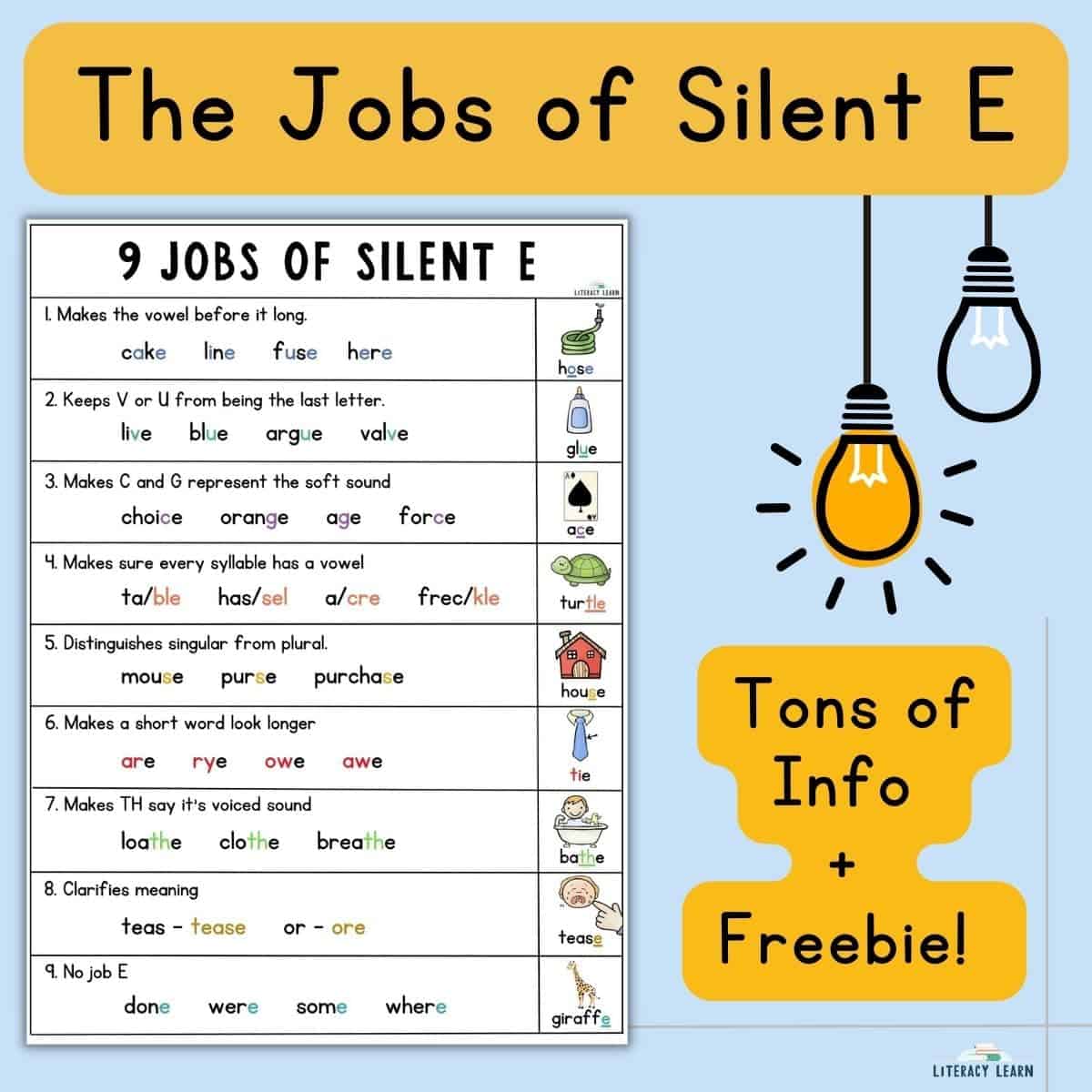
9 Jobs of E
Silent Final E appears at the end of a word or syllable. It has nine different functions:
- Job 1: Makes the vowel before it long (snake, cone).
- Job 2: Keeps V or U from being the last letter (have, blue).
- Job 3: Makes C and G represent the soft sound (ace, cage).
- Job 4: Makes sure every syllable has a vowel (waf-fle).
- Job 5: Distinguishes singular from plural (house, purse).
- Job 6: Makes a short word look longer (tie, are).
- Job 7: Makes TH says its voiced sound (soothe, wreathe).
- Job 8: Makes the meaning clear (or ➡️ ore).
- Job 9: No job E.
It’s important to explicitly teach the many jobs to students because about 6,000 English words include the final Silent E. Students who know all the jobs will become more confident readers and spellers!
💡Did you know? Sometimes the final Silent E can have multiple jobs! In the word “face,” the E makes the preceding vowel long AND it softens the C.
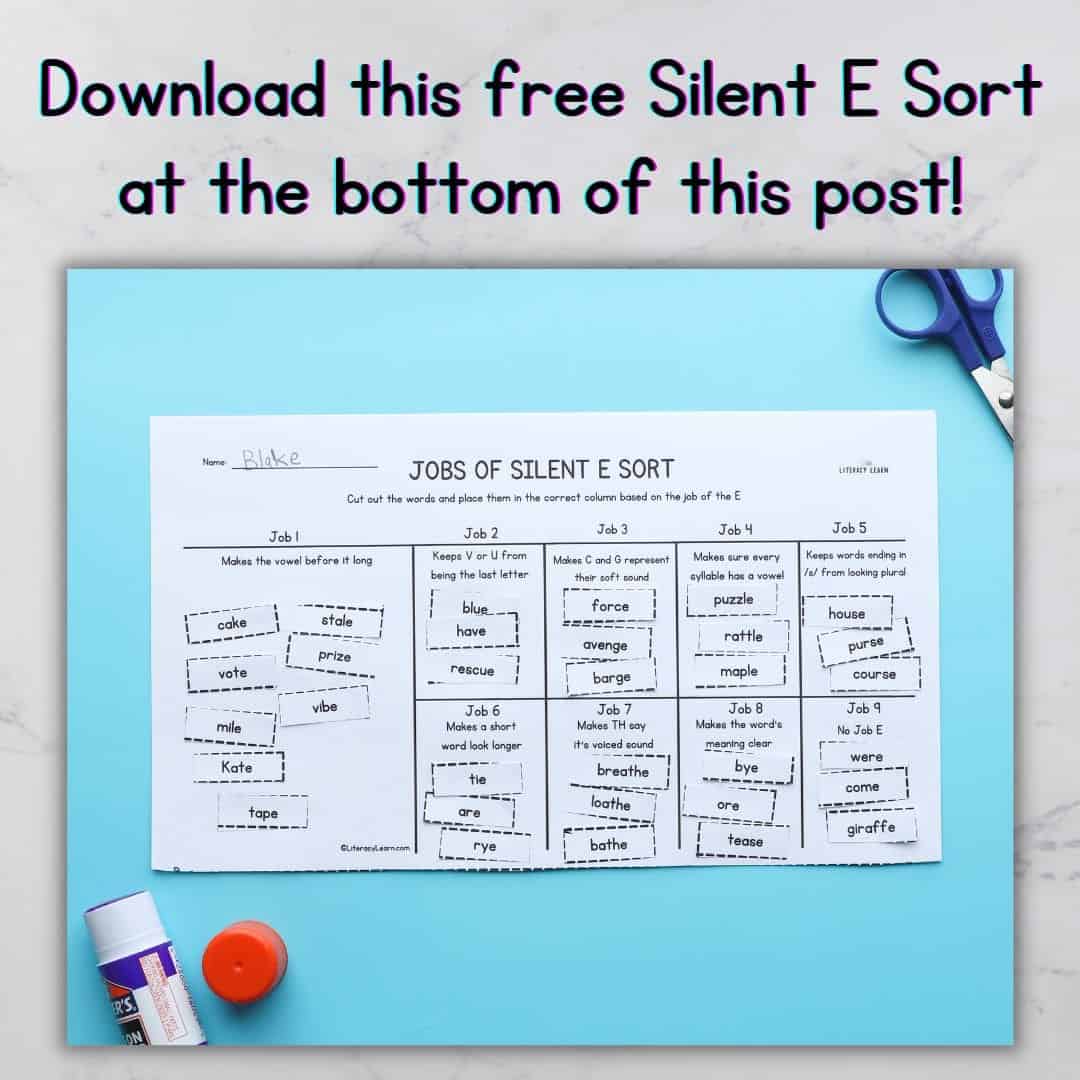
Job 1: Long Vowel
The first job of final silent E is that it makes the vowel before it long.
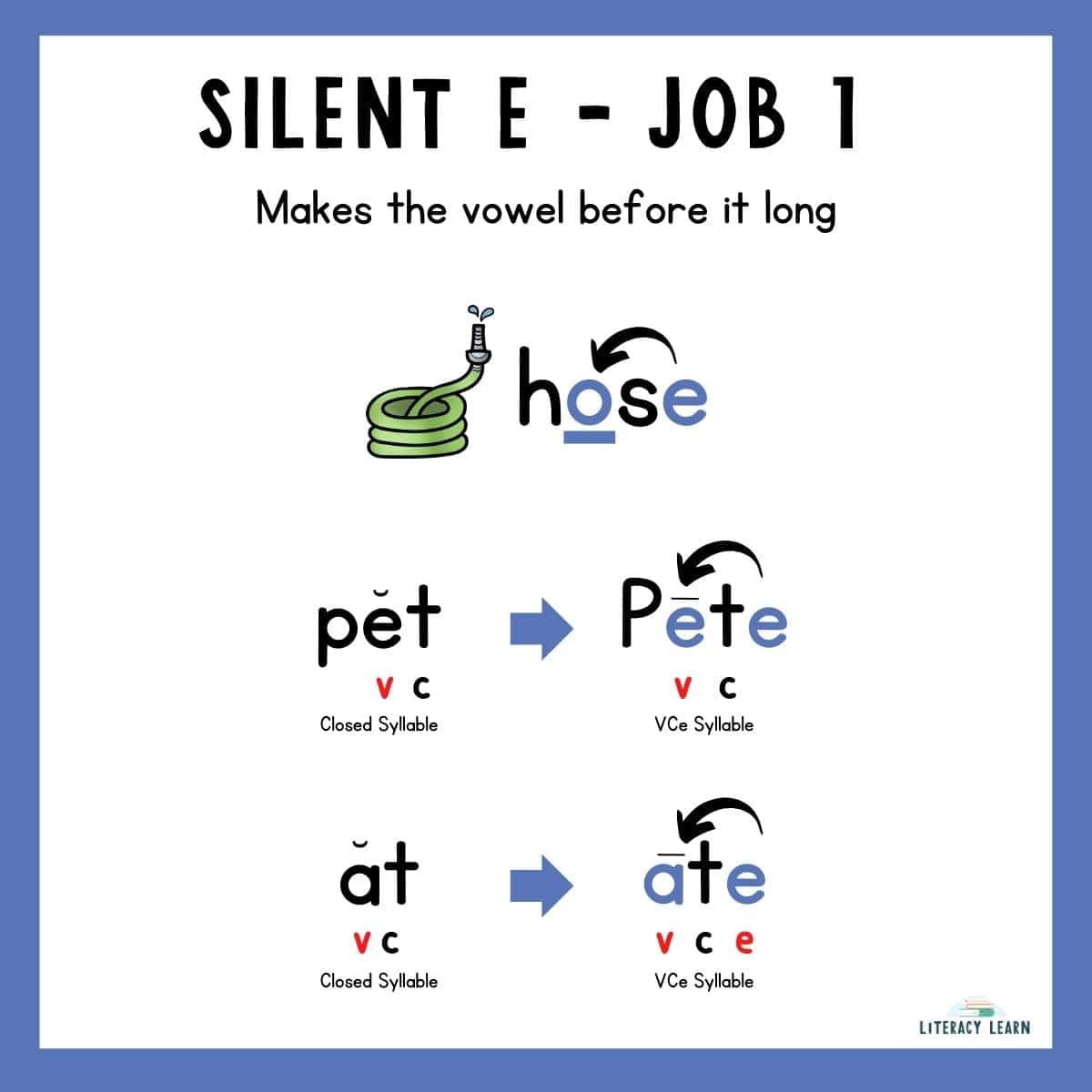
This is the most well-known job for the final silent E because it occurs in over 50% of words with a silent E. They’re sometimes referred to as Magic E words, Bossy E words, or VCe words.
These words follow a VCe spelling pattern (vowel-consonant-e), and they represent one of 6 syllable types.
In VCe words, the E has a very important job. It totally changes the vowel sound that comes before it. The silent E makes the vowel represent its long sound, or say its name.
When you add a final silent E on these CVC words, notice how both the word and meaning changes:
- win → wine
- pan → pane
- fir → fire
- not → note
- kit → kite
✨ Free Resources: To help teach this rule that occurs in about 3000 English words, check out our free resources. Get a comprehensive word list plus 7 picture match Silent E Worksheets. Get a free VCe Roll and Read game to make learning fun! You can also learn about CVCe word mapping to help kids orthographically map VCe words.
Job 2: U & V (Spelling Rule)
The second job of final silent E is that it keeps V or U from being the last letter in a word.
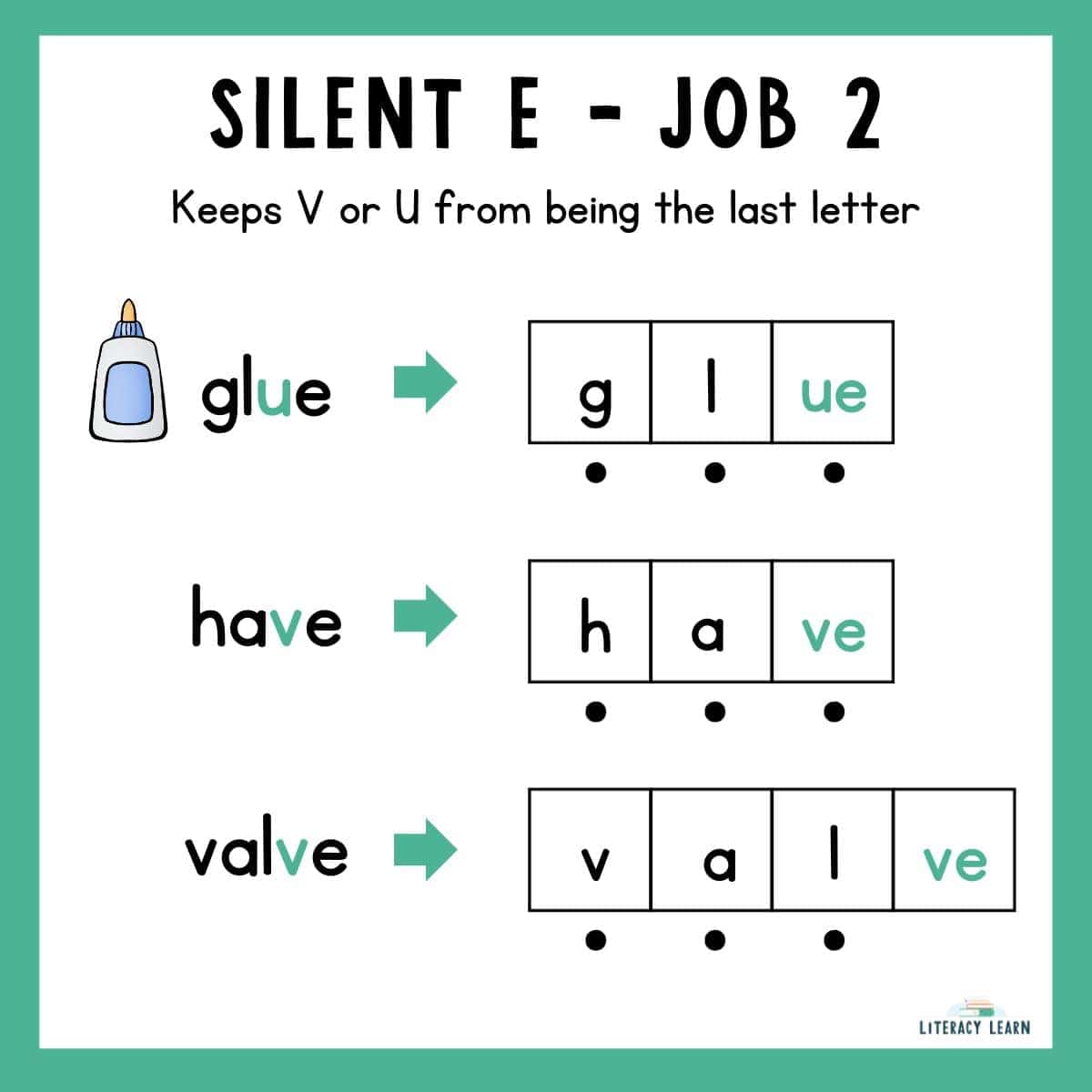
This job is important because it keeps words aligned with an important spelling rule for words in English. The rule is: English words will NEVER end in V or U. So this job keeps words from breaking the spelling rule.
💡I used to teach words like “due, have, and blue” as irregular words to be memorized. Now, I teach kids the spelling rule along with the second job of E. And now these words are perfectly decodable and can be spelled consistently using orthographic mapping!
✨ Free Resource: Want to know more about the spelling rules you should be teaching? Learn all about Spelling Rules and grab some great resources while you’re there!
Job 3: C & G (Spelling Rule)
The third job of final silent E is that it makes G and C say their soft sounds: G says /j/ and C says /s/.
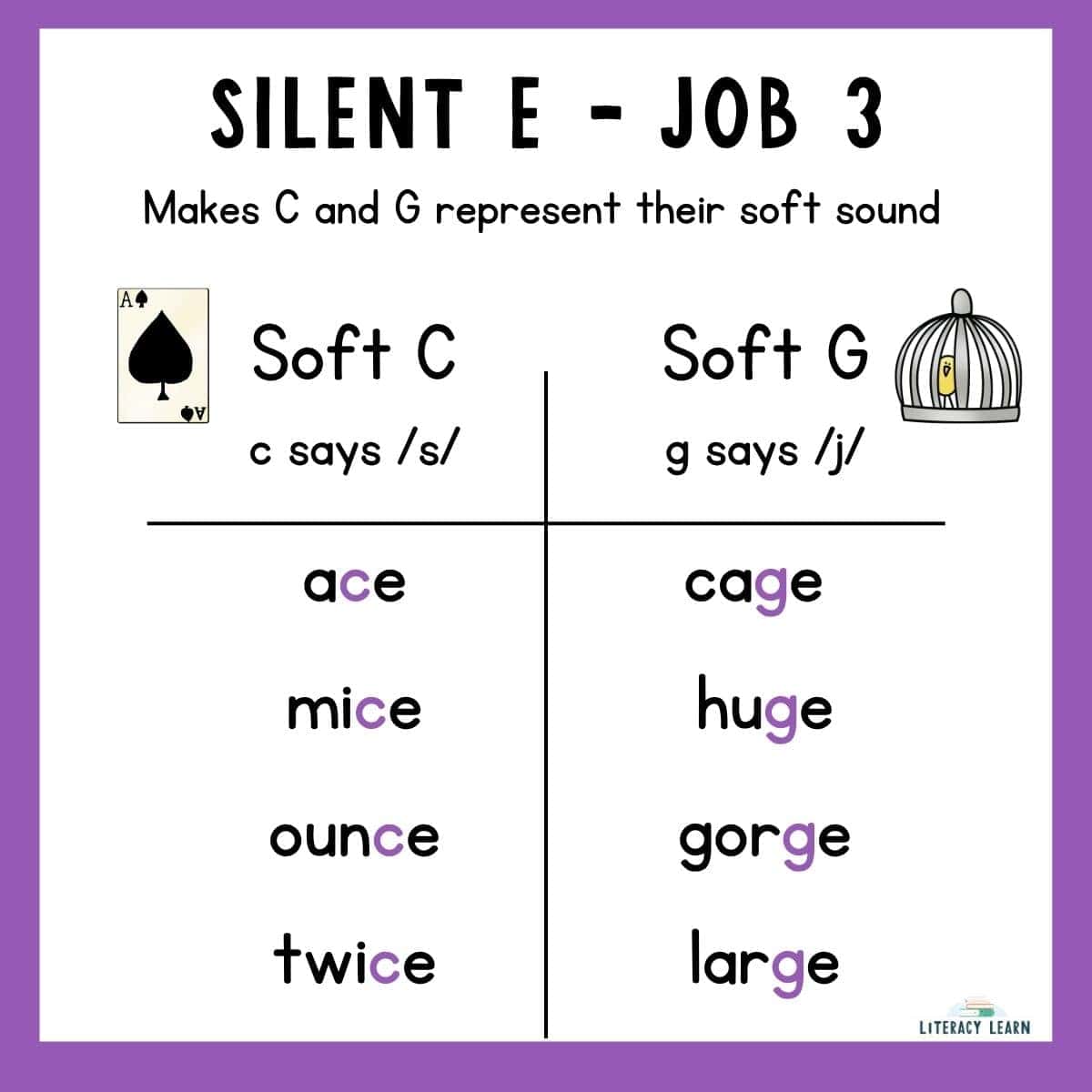
Another spelling rule, sometimes referred to as the Gentle Cindy Rule, is that when a G or C is followed by the letters E, I, or Y, it makes the consonant say its soft sound.
In this job, the E softens the C and G. This can be found in words like cage, ice, and lunge.
✨ Free Resources: Learn more about the Soft C and G rule and grab a free anchor chart. For sorting worksheets to practice, get our Soft C worksheet and Soft G worksheet.
Job 4: Make It a Syllable
The fourth job of the final silent E is to make sure every syllable has a vowel.
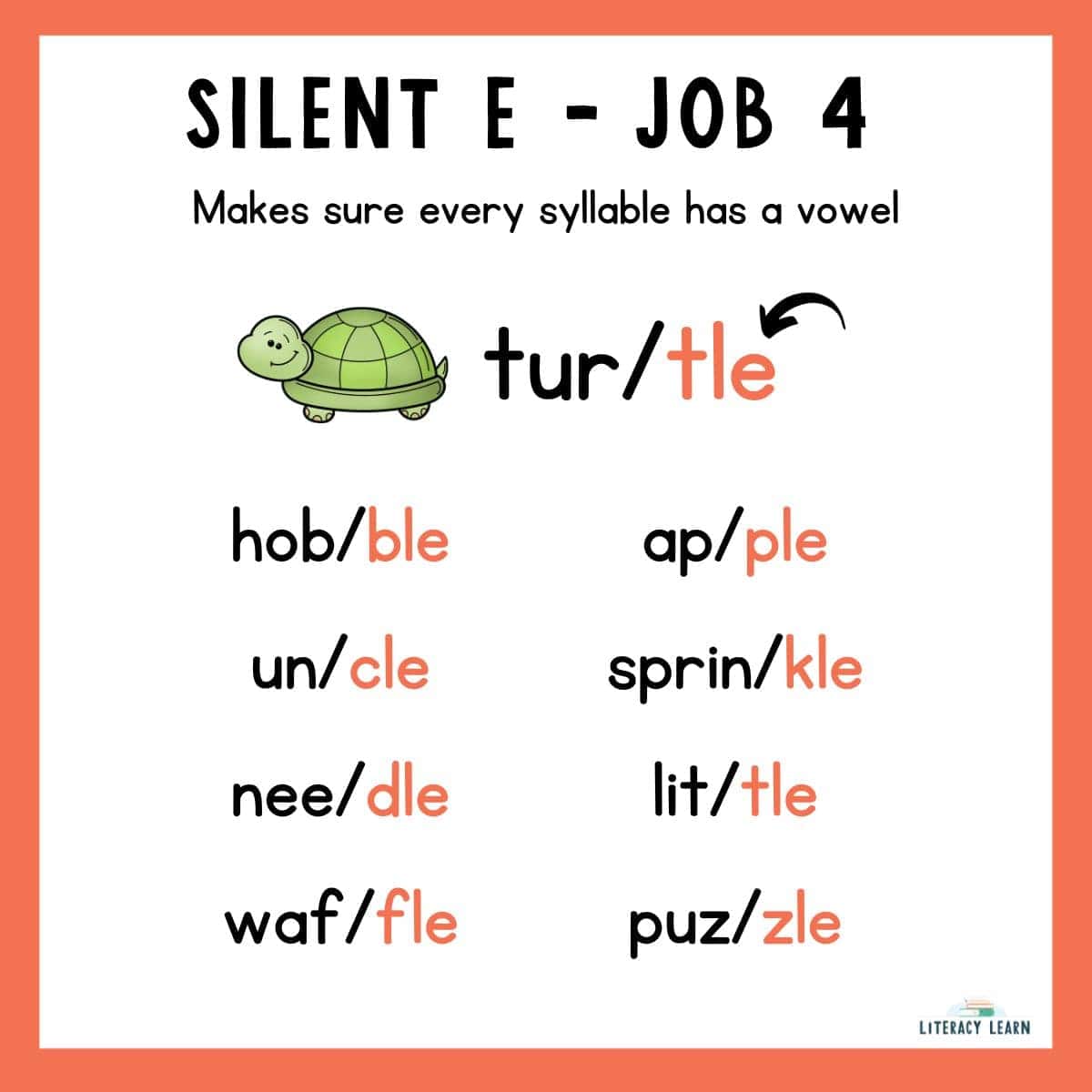
In the consonant-le syllable type, the final syllable in the word ends in a consonant-l-final E. The E is silent, but it fulfills the job of ensuring that this syllable type has a vowel.
In consonant-le words, the E is silent, but the final syllable includes a schwa sound. This usually sounds like /uh/ between the two consonants. You can hear this sound in the second syllable in words like bubble, candle, and trample.
✨Free Resource: Read more about C+le Words and get two lists with over 140+ words. Then get a C+le Worksheet for students to practice.
Job 5: Singular/Plural
The fifth job of the final silent E is that it clarifies singular words ending in /s/ and keeps them from looking plural.
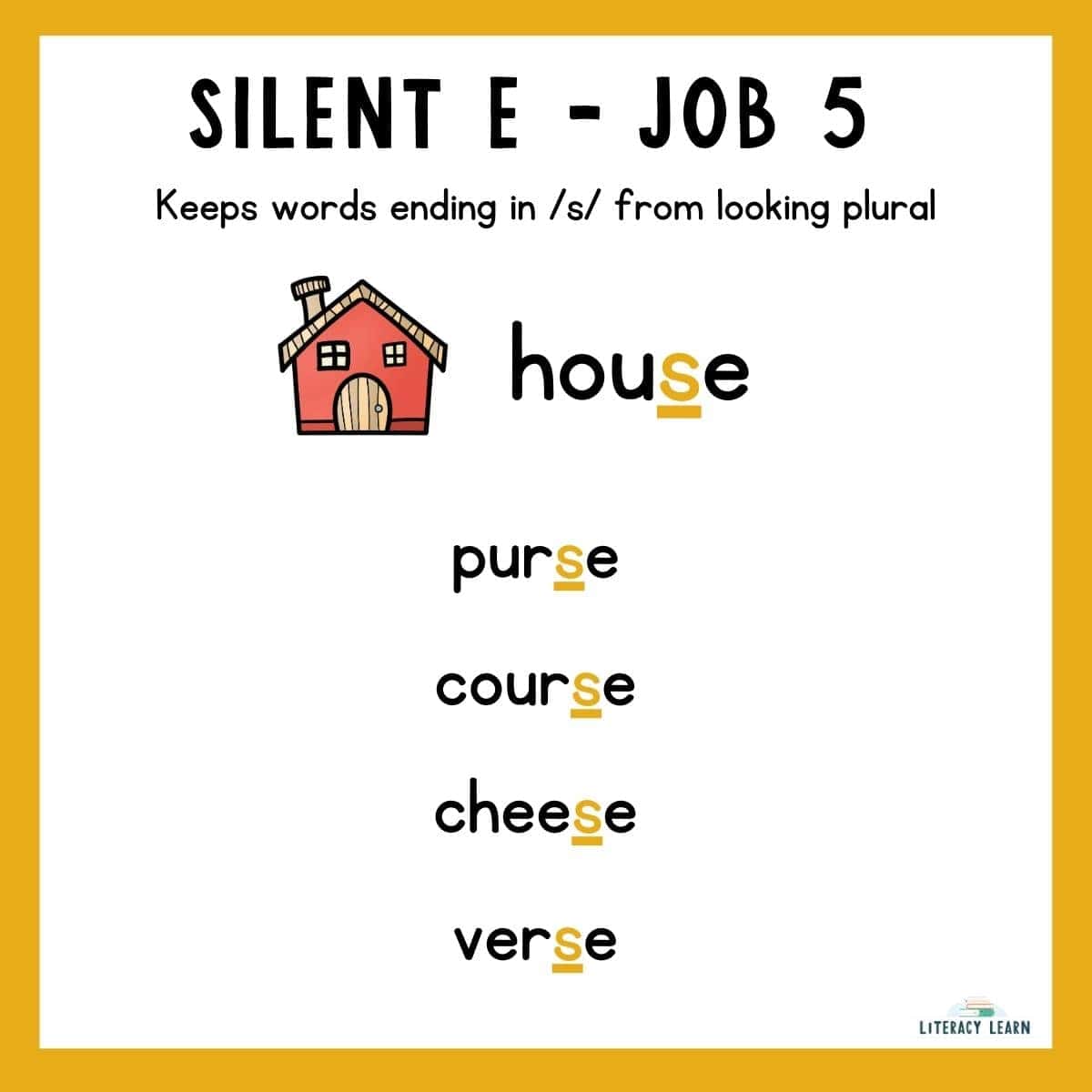
Since we normally add the suffix -s to make a word plural, so it can get confusing to distinguish words that actually end with the /s/ sound and words that include the suffix -s.
Think about these words: house, purse, cheese, and purchase. The last sound we hear in these words is /s/. But they include a final silent E so we know the word is singular!
Job 6: Longer
The sixth job of the final silent E is that it makes a short word look longer.
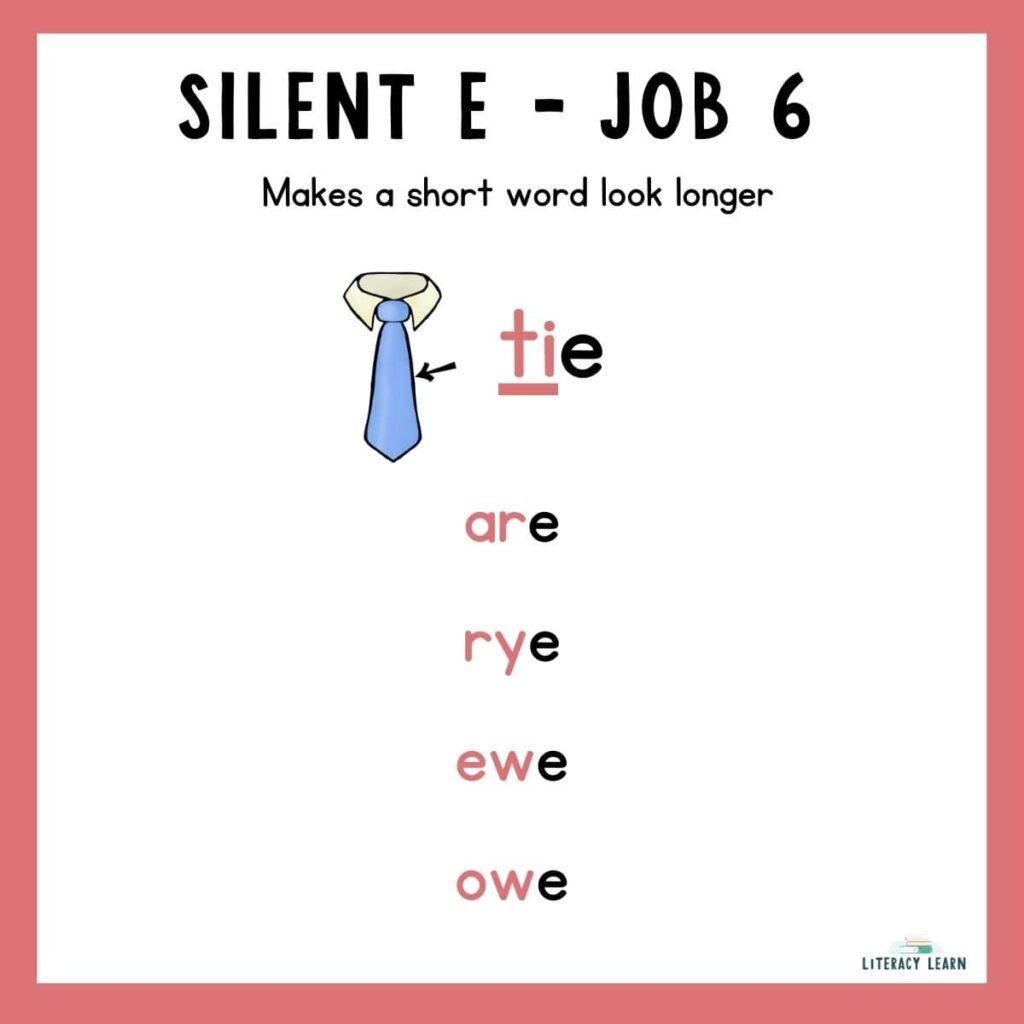
This may seem silly, but there is something visually appealing to a longer word like ‘are’ rather than ‘ar.’
This is a simple one to teach as you consider the various jobs of the final silent E.
Job 7: Voiced/Voiceless TH
The seventh job of the final silent E is that it makes TH say its voiced sound.
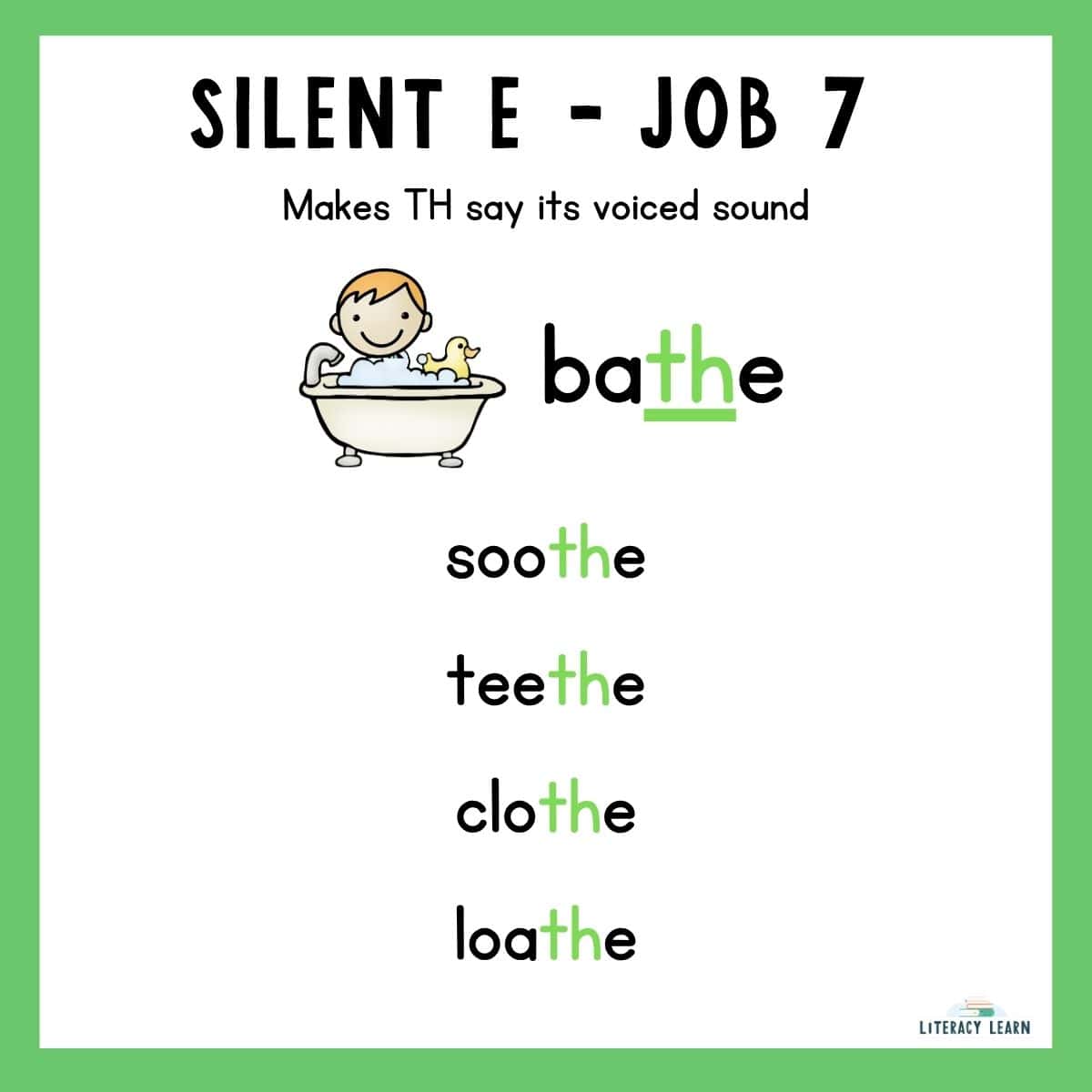
Say these words aloud, one after the other:
- bath → bathe
- wreath → wreathe
- cloth → clothe
The last sound in the first set of words represents an ‘unvoiced’ /th/ sound. But notice how the pronunciation changes when you add the final E the end of the word. This is because the /th/ sound is now voiced.
You should be able to clearly hear the difference between the voiced and unvoiced /th/ sound (and sometimes, the vowel sound changes too!).
Remember, voiced sounds turn the voicebox on (you can feel the vibration) while unvoiced sounds have only air coming out and do not make any vibration on the voicebox.
Job 8: Makes the Meaning Clear
The 8th job of the final silent E is that it clarifies meaning.
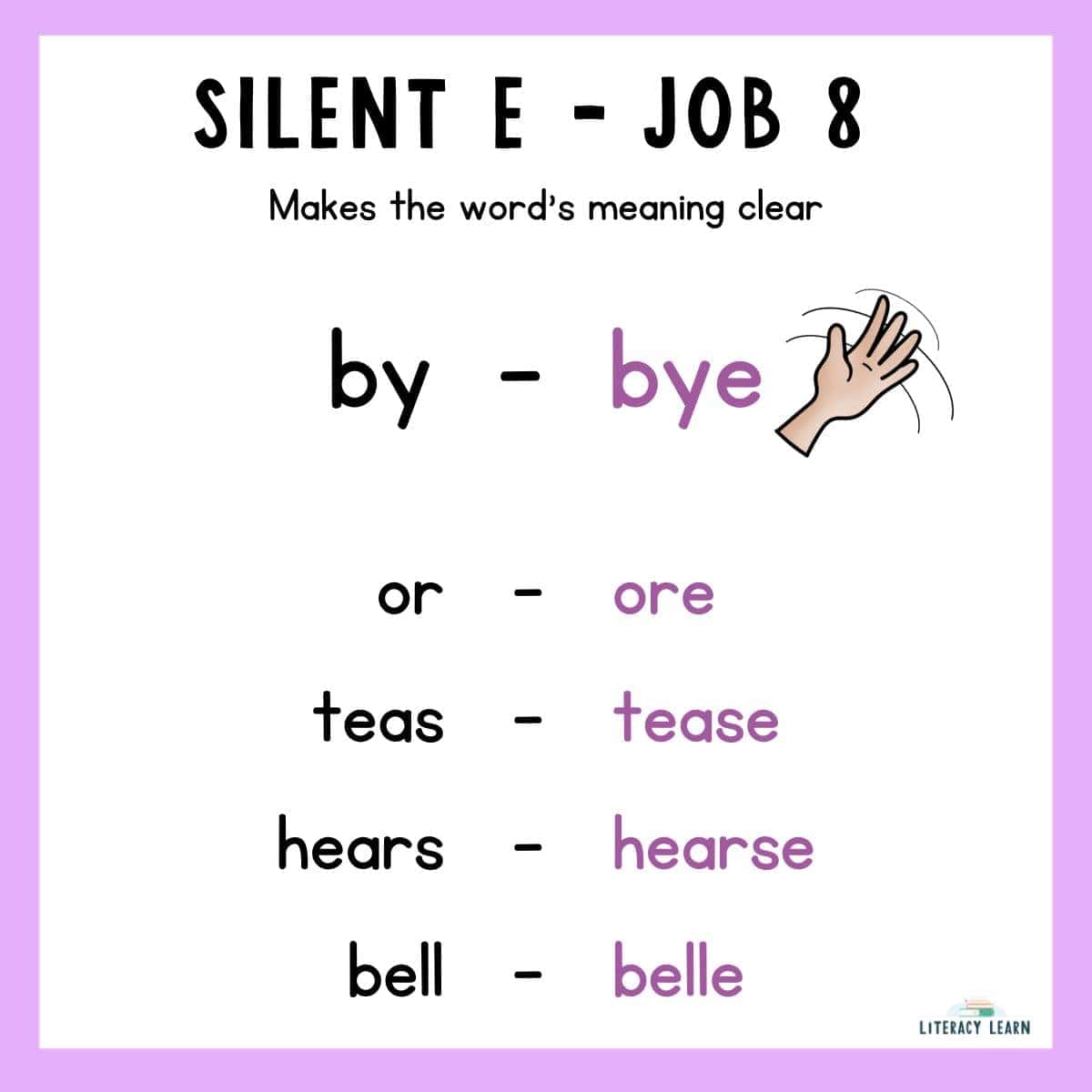
This is especially helpful in homophones, like in the words:
- teas/tease
- by/bye
- bell/belle
- hears/hearse
✨ Free Resources: Read more about the best activities for teaching homophones, and get common homophone lists and sentences and homophone worksheets to practice!
Job 9: No Job E
The ninth job of the final silent E is that it has no job; it cannot be explained.
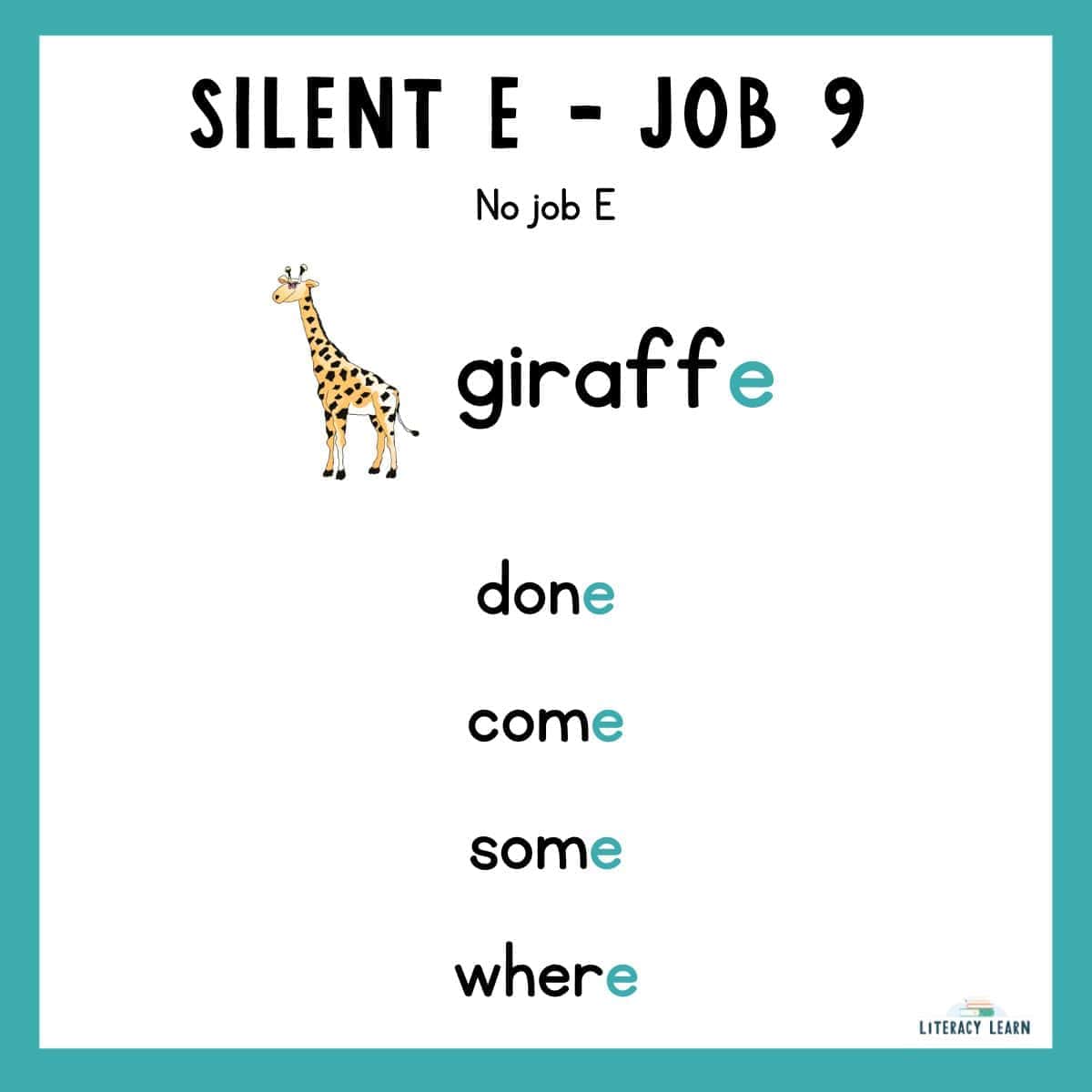
This was always my kids’ favorite job when they learned this concept – the no job E. They loved finding and marking words that had the lazy bum we called “no job E.”
In words like come, were, and done, we have no explainable reason for why the E is there. So, the spelling of these words just needs to be memorized.
✨ Free Resource: For more on teaching irregular words that need to be memorized, read about heart words and get free resources to help your students practice.
Conclusion
If you never knew about the MANY jobs of the final silent E, do not fret! It’s a new concept to many of us. We just love and appreciate that so many parts of the English language can be explained through explicit phonics instruction and spelling patterns.
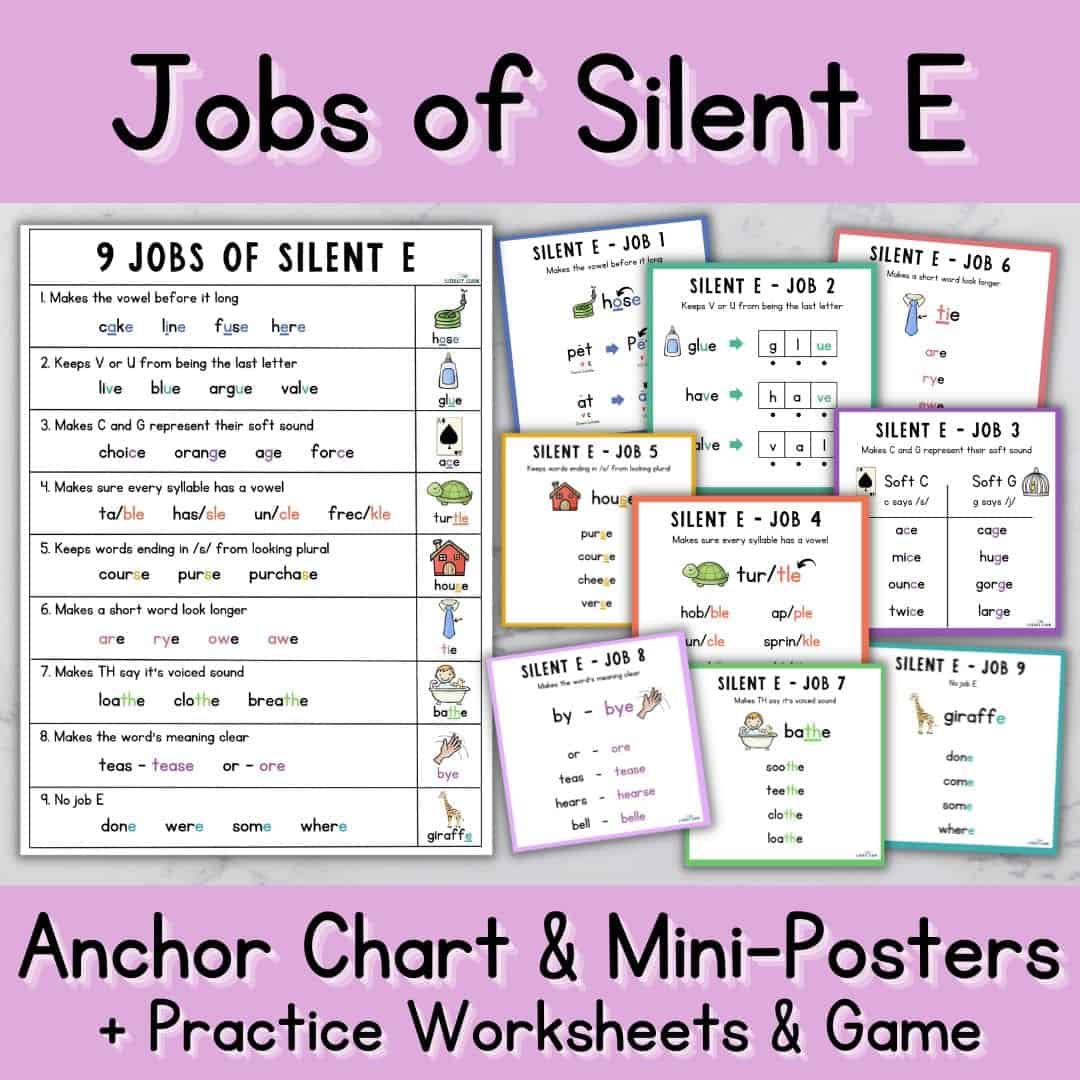
If you want the above graphics in high definition to be able to display in your classroom, visit our TPT store and get the Final Silent E bundle (pictured above).
Included are lots of great resources to help make your instruction effective. It’ll give kids the practice they need to be successful. Worksheets, games, mini-posters, and more!
Literature Connection: When teaching this concept, be sure to read this amazing book entitled “The Mighty Silent E.”
📗 Credit: The majority of this information was taken from the fabulous book: Uncovering the Logic of English (2012) by Denise Eide. Grab your copy here and get reading about “a common-sense approach to reading, spelling, and literacy.” It’s the best.
Download & Print (Silent E Sort)
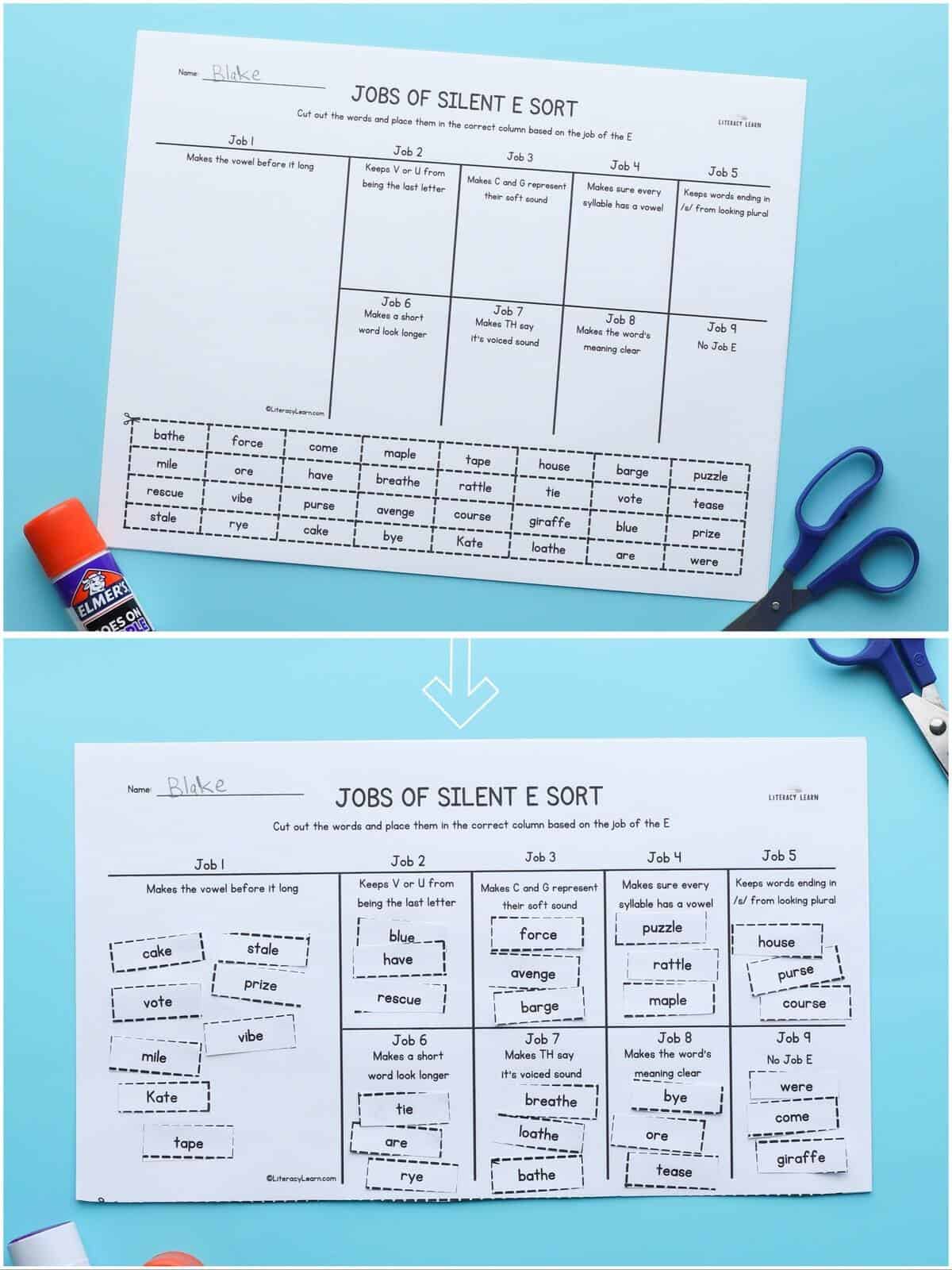
Learning to recognize the jobs of E will help limit confusion and help reading and spelling skills improve!
Use the free printable Silent E job sort for kids to practice sorting words according to the job of the Silent E. Kids will cut, sort, glue, and read words.
They can even use their pencils to write in more words they come across on the chart!
We’d love to hear about your experience using this resource!
Please leave a comment below or tag us on Instagram @literacylearn!
DOWNLOAD TERMS: All of our resources and printables are designed for personal use only in homes and classrooms. Each teacher must download his or her own copy. You may not: Save our files to a shared drive, reproduce our resources on the web, or make photocopies for anyone besides your own students. To share with others, please use the social share links provided or distribute the link to the blog post so others can download their own copies. Your support in this allows us to keep making free resources for everyone! Please see our Creative Credits page for information about the licensed clipart we use. If you have any questions or concerns regarding our terms, please email us. Thank you!



I would like to challenge you a little bit on your understanding of the jobs of . What you have listed as job 6 – makes a word look longer and job 8 – clarifies the meaning, is actually the same job. The only reason why a word needs to be longer is because it is a content word and NOT a function word. Content words (a word that holds meaning such as a verb, noun, adverb, and adjective) must have a minimum of 3 letters. Function words do not need to follow this rule. Thus lexicalizes the word. In turn, it clarifies the meaning. is a function word but is a content word. Plus, some of the other words you have listed under job 8 can be explained by job 5. is a plural but is not nor is . Why have more jobs for than are necessary. I am really dismayed by resources that suggest there is “No job e” or “Silly e”. This shows a lack of understanding of the English language and how it came to be. May I suggest searching words on etymonline to find out why these words contain ? Some are a result of being imported from other languages and some were designated to show relationships with other related words. For example is related to .
Hi Charlene,
Thank you for your comment. We do appreciate hearing from other educators …we are all on this learning journey together! We always strive to use current research and credible resources as we write our posts as we only want to share correct information with others. We used Denise Eide’s (2012) Uncovering the Logic of English as we wrote about the 9 Jobs of Silent E (as credited in the post). This is a well-accepted book within the literacy and educational community, so we feel confident about the jobs of E as outlined in the post and in the free resource. We do love the idea you shared about using etmyonline to uncover a word’s origin to explain the spelling. Thanks again for your thoughts.
Katie and Laura
Very helpful visuals!
Jocelyn,
We are so glad you find them helpful!
Katie and Laura